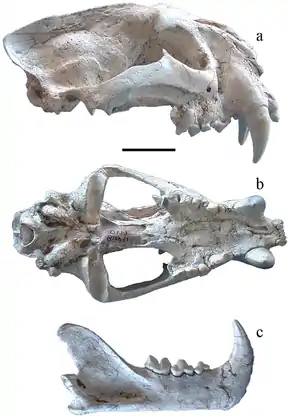Panthera zdanskyi
Tigre de Longdan

| Règne | Animalia |
|---|---|
| Embranchement | Chordata |
| Classe | Mammalia |
| Infra-classe | Placentalia |
| Ordre | Carnivora |
| Sous-ordre | Feliformia |
| Famille | Felidae |
| Sous-famille | Pantherinae |
| Genre | Panthera |
Le Tigre de Longdan[1] (Panthera zdanskyi) est une espèce éteinte de grand félins de la sous-famille des Pantherinae et du genre Panthera, très proche du tigre actuel, connu de la province du Gansu au nord-ouest de la Chine[2].
Description
Panthera zdanskyi est découvert en 2004 dans le gisement fossile de Longdan en Chine. Ce fossile est daté d'il y a 2,55 à 2,16 millions d'années (début du Pléistocène). L'analyse cladistique montre que Panthera zdanskyi est le taxon frère du tigre et conduit à penser que le berceau du tigre moderne se situe au début du Pléistocène dans le nord-ouest de la Chine[3].
Phylogénie

Cladogramme basé sur l'analyse phylogénétique des espèces vivantes et éteintes (†) du genre Panthera réalisée par P. Piras et ses collègues en 2018[4]. P. zdanskyi y est placée en groupe frère du Tigre actuel (Panthera tigris) :
| Panthera |
| |||||||||||||||||||||||||||||||||||||||||||||||||||||||||||||||||||||
Cladogramme établi par Mazák, Christiansen et Kitchener en 2011[5] :
| Pantherinae |
| ||||||||||||||||||||||||||||||||||||||||||||||||||||||
Étymologie
Panthera zdanskyi a été nommé par Ji H. Mazák, Per Christiansen et Andrew C. Kitchener en 2011. Le nom spécifique honore le paléontologue autrichien Otto Zdansky.
Notes et références
Notes
- (en) Cet article est partiellement ou en totalité issu de l’article de Wikipédia en anglais intitulé « Panthera zdanskyi » (voir la liste des auteurs).
Références
- Le nom vernaculaire de « Tigre de Longdan » (« Longdan Tiger ») est proposé par les découvreurs de cette espèce.
- Ji H. Mazák, Per Christiansen and Andrew C. Kitchener, « Oldest Known Pantherine Skull and Evolution of the Tiger », PLoS ONE, vol. 6, no 10, , e25483 (DOI 10.1371/journal.pone.0025483, lire en ligne)
- (en) Ji H. Mazák, Per Christiansen et Andrew C. Kitchener, « Oldest Known Pantherine Skull and Evolution of the Tiger », PLoS ONE, vol. 6, no 10, (DOI 10.1371/journal.pone.002548, lire en ligne)
- (en) Piras, P., Silvestro, D., Carotenuto, F., Castiglione, S., Kotsakis, A., Maiorino, L., Melchionna, M., Mondanaro, A. et Sansalone, G., Serio, C. et Vero, V.A., « Evolution of the sabertooth mandible: A deadly ecomorphological specialization », Palaeogeography, Palaeoclimatology, Palaeoecology, vol. 496, , p. 166−174 (DOI 10.1016/j.palaeo.2018.01.034, Bibcode 2018PPP...496..166P)
- (en) J. H. Mazák, P. Christiansen et A. C. Kitchener, « Oldest Known Pantherine Skull and Evolution of the Tiger », PLOS ONE, vol. 6, no 10, , e25483 (ISSN 1932-6203, PMID 22016768, PMCID 3189913, DOI 10.1371/journal.pone.0025483, Bibcode 2011PLoSO...625483M)
Annexes
Articles connexes
Bibliographie
- (en) Ji H. Mazák, Per Christiansen et Andrew C. Kitchener, « Oldest Known Pantherine Skull and Evolution of the Tiger », PLoS ONE, vol. 6, no 10, (DOI 10.1371/journal.pone.002548, lire en ligne)
- Portail des félins
- Portail de la paléontologie
- Portail du Cénozoïque